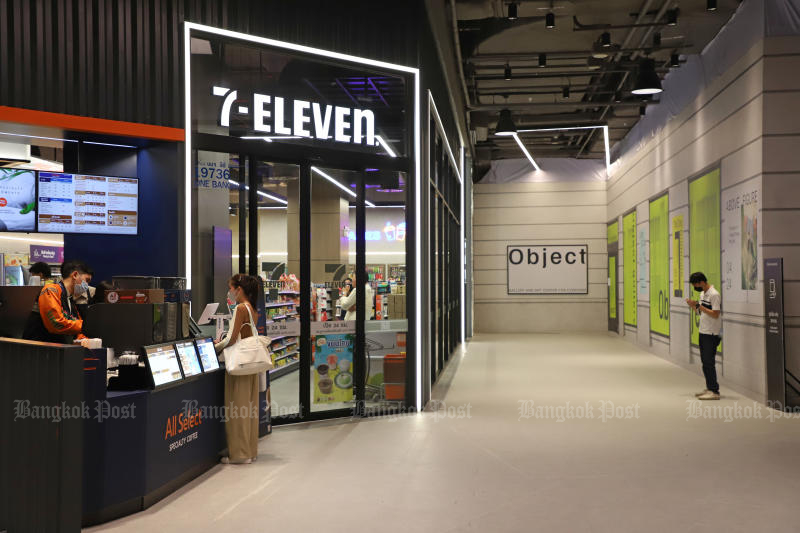A Tokyo store is piloting worker robots as part of a broader automation push to address persistent labor shortages and rising wage costs. The initiative by 7-Eleven Japan Co. introduces robots to stock drinks and clean areas, while also testing a remote-service screen to assist late-night cashiers. In addition, the company is conducting a separate trial with delivery robots designed to carry goods from stores to customers’ homes. The program signals a strategic shift toward automation in Japan’s convenience-store sector, aiming to maintain service levels and efficiency amid staffing pressures. The trial underscores how retailers are balancing cost control, safety, and customer experience as they explore robotic solutions for routine, high-volume tasks.
Automation push in Tokyo: addressing labor shortages and wage pressures
The ongoing automation push at 7-Eleven Japan Co. represents a deliberate response to a tight labor market and elevated wage costs that have become a defining challenge for retailers across Japan. By introducing worker robots into a Tokyo store, the company is testing how machines can take over repetitive, physically demanding, and time-consuming tasks that traditionally require human labor. The core idea is to free up human associates to devote more attention to customer service, problem-solving, and tasks that benefit from human judgment, while ensuring that the store maintains optimal stock levels and cleanliness. Such a strategy is particularly relevant in urban centers like Tokyo, where foot traffic is high and operations must run efficiently around the clock.
This trial aligns with a broader industry trend in which retailers are leveraging automation to sustain store performance in the face of labor shortages. As workers become harder to recruit and retain, wage costs tend to rise, eroding margins and limiting the ability to staff stores to peak capacity. Automation offers a potential pathway to stabilize operating costs while preserving the core customer experience. The Tokyo store serves as a controlled environment where the effectiveness of robotics in day-to-day retail operations can be closely monitored, measured, and refined before broader deployment. The decision to proceed with a multi-faceted robot program reflects a careful balance between capital expenditure, maintenance needs, and the anticipated return in terms of labor efficiency and service consistency.
In this context, the Tokyo initiative also signals a strategic shift in how retailers view roles within the store. Rather than simply replacing human labor, robots are being positioned as complements that handle high-frequency, routine tasks. This approach can help reduce the physical strain on workers, lower safety risks associated with heavy lifting and repetitive motions, and improve overall store workflow. Yet it also raises questions about job design, training needs, and the integration of automated systems with existing human teams. 7-Eleven Japan appears to be approaching these considerations with a focus on operational continuity, customer experience, and long-term scalability. The Tokyo store thus becomes a focal point for evaluating technology readiness, staff adaptation, and the practical implications of large-scale automation in Japan’s retail sector.
Robotic roles: stocking beverages and cleaning, with an eye to efficiency and safety
The core function of the introduced robots centers on supporting stock management and store cleanliness. One robot is tasked with stocking bottled drinks and canned alcohol, taking on a duty that is repetitive, physically demanding, and time-consuming for human staff. By handling shelf replenishment, the robot aims to ensure product availability and proper presentation, which are essential for sales performance in a busy convenience store environment. The use of robotics for stock management can also help reduce stock discrepancies, improve product placement accuracy, and speed up restocking cycles during peak hours or after promotional events. The capability to manage stock in dynamic retail settings may contribute to more consistent inventory control and a smoother shopping experience for customers.
In addition to stocking duties, other robots in the trial are designed to clean the store’s floors and windows. Cleaning tasks, while essential to maintaining a welcoming environment, are labor-intensive and can become burdensome during late-night or early-morning shifts. By delegating cleaning responsibilities to robots, the store can maintain high standards of cleanliness without relying exclusively on human labor, thereby potentially reducing labor shortages during critical operating windows. The cleaning robots must navigate aisles safely, avoid disrupting customers, and work around merchandise and equipment without causing damage. Their effectiveness rests on reliable sensors, precise navigation, and robust maintenance protocols to prevent downtime that could impact store operations.
The deployment of robots for stocking and cleaning also has implications for workflow design within the store. Human employees can be redeployed to higher-value tasks, such as assisting customers, managing promotions, or handling complex queries that require human judgment. This reallocation can help improve customer service quality during busy periods, as team members focus on interactions and problem-solving rather than being tied to repetitive tasks. The robots’ performance will depend on how well they integrate with existing systems, including inventory software, point-of-sale (POS) setups, and store layout specifics. The trial’s success will hinge on the robots’ ability to operate reliably in a dynamic retail environment, respond to unexpected tasks, and maintain consistency in task execution.
Moreover, the trial anticipates ongoing maintenance needs, including software updates, sensor recalibration, and occasional hardware servicing. Effective maintenance is crucial to minimize downtime and ensure that robots continue to perform as intended. The store will need to implement monitoring protocols to track robot uptime, task completion rates, and any incidents involving safety or customer interaction. While the primary goals are efficiency and consistency, the broader objective is to demonstrate that a combination of automation and human labor can deliver a resilient retail operation, especially in the face of staffing challenges and rising wage costs.
Remote-service screens: extending cashier capabilities during late-night hours
In parallel with physical-task robots, the Tokyo store has introduced a screen that enables customers to be served remotely, aiming to ease the workload on cashiers during late-night shifts. This remote-service capability suggests a hybrid model where customer interactions can be supported by off-site staff or automated systems, reducing the direct burden on on-site human cashiers during off-peak hours. The remote-service screen could allow customers to complete transactions, seek help, or receive guidance without requiring a full-time cashier presence, thereby enabling the store to operate more efficiently during hours when staffing levels are leaner.
The use of remote service tools raises several considerations for the customer experience. On the one hand, customers may benefit from faster service and reduced wait times when human staff are able to support multiple tasks remotely or remotely supervise automated checkout processes. On the other hand, there could be concerns about the ease of use, privacy, and perceived personal connection with staff. The store will need to ensure that the remote service remains intuitive, secure, and reliable, maintaining trust and satisfaction among customers who expect quick, friendly service at all hours. Training for both customers and staff will be essential to maximize the effectiveness of this approach.
From an operational perspective, remote service can help balance labor costs with service quality. If a remotely supported system can handle routine inquiries and simple transactions, it may allow human cashiers to focus on more complex tasks or assist customers with specialized needs. The store will also assess whether the remote component enhances throughput during late-night periods, potentially enabling extended hours of operation without a proportional increase in on-site staff. The success of this feature will depend on system stability, user acceptance, and the ability to seamlessly integrate with existing POS and inventory workflows.
This remote-service approach is part of a broader exploration of how technology can augment frontline roles while preserving the human touch where it matters most. Retailers are increasingly testing how digital interfaces, automation, and remote support can coexist with in-person interactions to deliver consistent service levels. The Tokyo store’s experience will yield insights into best practices for deploying remote-service tools in high-traffic retail settings and how they can complement physical automation to optimize overall store performance.
Delivery robots: piloting automated home deliveries as a separate trial
In addition to in-store robots, 7-Eleven Japan Co. has begun a separate trial using delivery robots to transport goods from stores to customers’ homes. This initiative expands the scope of automation beyond shelf replenishment and cleaning into end-to-end service delivery. The delivery robots are designed to bridge the gap between store shelves and customers’ doorsteps, addressing the growing demand for quick, convenient, and contactless delivery options in urban areas. The trial’s outcomes will be closely watched for signs of how reliable autonomous delivery can be in the fast-paced urban environment, where traffic, sidewalks, and varying weather conditions can influence performance.
The delivery-robot trial reflects retailers’ interest in diversifying service channels and enhancing last-mile capabilities. By exploring autonomous delivery, the company can evaluate factors such as route optimization, obstacle avoidance, package handling, and customer verification. The operation’s success will rely on dependable navigation, safe interaction with pedestrians and other road users, and robust integration with inventory and order-management systems. If successful, delivery robots could contribute to improved delivery times, reduced human labor requirements for last-mile tasks, and enhanced customer satisfaction through more predictable service.
As with in-store robotics, the delivery-robot program will necessitate careful monitoring and ongoing adjustments. Safety protocols, privacy considerations, and regulatory compliance will be essential components of any deployment. The company will need to analyze cost-benefit scenarios, including capital expenditures, maintenance costs, energy usage, and potential savings from labor reductions. The outcomes of the delivery-robot trial will influence strategic decisions about whether to scale this technology across more locations and how to coordinate it with existing delivery ecosystems, including any collaborations with external logistics partners.
Implications for operators, workers, and the broader retail landscape
The concurrent introduction of in-store robots and delivery robots signals a broader shift in how retailers approach workforce planning and service delivery. For operators, automation can offer a path to sustaining performance amid labor shortages and rising wages. By taking on repetitive tasks, robots can reduce the physical burden on human workers, enable more efficient workflows, and help maintain consistent service levels during peak periods. The ability to allocate human resources to higher-value interactions with customers can improve overall store performance and customer satisfaction, even as staffing becomes more challenging.
From a workers’ perspective, automation brings a mix of opportunities and challenges. On the one hand, robots can take over strenuous and monotonous tasks, potentially reducing the risk of injury and fatigue for human staff. On the other hand, workers may need to adapt to new roles, acquire new technical skills, and shift toward more supervisory or customer-centric responsibilities. Training programs and change-management strategies will be essential to ensure smooth transitions and to minimize disruption to daily operations. The long-term impact on job prospects will likely vary by role, location, and the pace at which automation is adopted across the retail sector.
The broader retail ecosystem will be watching closely for indications of scalability, reliability, and customer receptiveness to automated services. Success in Tokyo could encourage broader deployment across Japan and possibly beyond, especially if the pilot demonstrates measurable improvements in stock accuracy, cleanliness standards, service speed, and delivery efficiency. Regulators and policymakers may also take note of how automation affects employment dynamics, urban mobility, and consumer experience in essential retail services. Retailers could increasingly view automation as a core strategic asset rather than a supplemental convenience, shaping investment decisions and competitive dynamics in the sector.
Technological considerations will continue to shape how these robotic initiatives evolve. Robust sensor suites, reliable machine vision, secure network connectivity, and resilient software platforms will be critical to maintaining uptime and ensuring safe operation around customers and inventory. Interoperability with existing store systems—such as inventory management, POS, and promotional pricing—will determine how smoothly robots integrate into daily workflows. Maintenance regimes, spare-parts availability, and operator training will also influence the long-term viability and cost-effectiveness of large-scale automation programs. The Tokyo trial provides a practical arena to test these elements in a real-world setting, offering lessons that can inform future deployments in other markets with similar labor market pressures.
Practical considerations, customer experience, and next steps
As 7-Eleven Japan continues to evaluate the robotics program, practical considerations will guide decisions about scaling and refinement. The effectiveness of robots in stocking and cleaning tasks will be measured by metrics such as replenishment accuracy, time-to-shelf, cleanliness standards, and the frequency of maintenance requirements. Customer-facing technologies, including the remote-service screen, will be assessed based on accessibility, ease of use, and the impact on perceived service quality during late-night hours. The delivery-robot trial will be assessed through delivery times, reliability, safety outcomes, and customer feedback regarding the convenience and security of automated home deliveries.
Retailers considering similar automation investments will look to Tokyo’s experience for insights into best practices, potential pitfalls, and integration strategies. Key considerations include how to balance capital expenditure with anticipated savings, how to manage staff transitions, and how to maintain a consistent brand experience across automated and human-assisted interactions. The ability to scale pilots into broader rollouts will depend on demonstrable returns, stakeholder buy-in, and effective risk management, including cyber security, data privacy, and regulatory compliance.
In the near term, expect continued experimentation with in-store robots for tasks such as stocking, cleaning, and customer support, along with explorations in autonomous delivery. The convergence of these technologies could lead to more integrated store ecosystems where robots handle routine operational tasks, while human associates concentrate on personalized customer engagement, strategic promotions, and complex problem resolution. The Tokyo trial will likely serve as a microcosm of how retailers can leverage automation to navigate labor market pressures while sustaining service quality and growth in a highly competitive urban retail environment.
Conclusion
7-Eleven Japan Co. has launched a comprehensive robotics trial in Tokyo that encompasses in-store robots for stocking and cleaning, a remote-service screen to support late-night cashier workloads, and a separate delivery-robot program for home deliveries. The initiative is driven by Japan’s labor shortages and rising wage costs, reflecting a broader industry push toward automation to maintain service levels and operational efficiency. By combining automated tasks with strategic human roles, the program seeks to optimize store performance, enhance customer experience, and explore scalable solutions for urban retail. The outcomes of these trials will inform broader adoption across the country and potentially influence how convenience stores balance automation with human-centric service in the years ahead.



